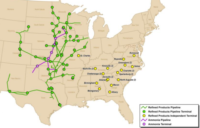The Panama Canal Authority (ACP) is seeking bids from global contractors for an estimated $2 billion of water-supply infrastructure projects to help fix low water levels attributed to climate change-generated drought conditions that are affecting canal operations despite conservation measures and new fees. The program, which will be 100% agency-financed, is intended to meet the strategic waterway's water needs as well; as local drinking water supply requirements for 50 years.
In a request for qualifications issued Sept. 7, the authority said the contractor will be responsible for program concept, design and construction, which will include identifying sites where component projects, will be built, and for all investigations, surveys and studies necessary, including hydrological, climatic and environmental conditions.
A short list will be developed late this year from companies submitting responses to the RFQ that will be allowed to submit proposals.
RFQ’s are due Nov. 12. ACP will select the best value proposal by the last quarter of 2021, an agency spokesman told ENR. Construction is expected to take four to five years.
Managing Water in the Tropics
The project must be built to United Nations Sustainable Development goals. The new water management system also must include water treatment plants for Panama City. “Historically low levels of water in recent years only exacerbated the need to adopt a comprehensive plan,” Ricaurte Vasquez, canal administrator, said in releasing the RFQ.
In February, ACP implemented a series of measures including fees on vessels that travel through the expanded canal and a reduced number of transit slots—some of which were awarded through an auction to keep water levels in the canal high enough for operations after the record setting drop in rainfall in recent years threatened to significantly affect the free flow of cargo through the canal, an ACP spokesman said.
Previous conservation measures including suspending hydroelectric plant operations and limiting the amount of cargo on ships had not kept water levels high enough. The agency also began cross filling locks, which the spokesman said is a method that sends water during transits between the two shipping lanes to save water.
The $5-billion expansion of the canal, completed in 2016, also put pressure on water resources.
About 50 million gallons of fresh water are lost through the locks to the Pacific and Atlantic oceans. Earlier this year when the latest conservation measures were put in place, Carlos Vargas, ACP executive vice president for environment, water and energy said, “We have no doubt that we need to build more reservoirs,”
Vargas blames the water shortage on climate change and said capital improvements are the most effective way to mitigate it.
In a report released in January, the authority found that rainfall in 2019 was 20% below the historic average—the fifth driest year in 70 years causing water levels to drop far below average. It followed several years of lower than average rainfall and an increase in water evaporation due to a rise in air temperatures.
Water levels were projected to drop below operational levels that would cause an “unprecedented impact” on customers.
Two artificial lakes, Gatun and Alajuela, provide water to the canal and to Panama’s population, but ACP said the Chagres River watershed, which supplies both, has no more water to give. In December 2018, precipitation in the watershed was approximately 90% below the historic average, causing water levels in both lakes to drop below normal.
Canal and Drinking Water supply
The “paramount objective” of the new water management system is to provide a holistic and integrated solution to solve the problem of quantity, quality and control of water for the canal basin and for drinking water, according to the RFQ, which states that responsibility for the approach will be the contractors alone.
ACP will take no responsibility for suitability of the design or the site.
The contractor’s solution should incorporate new sources of natural freshwater transfer from river basins near the Panama Canal basin and should provide an estimated 1.4 billion cu meters per year.
The solution should be based on “human and municipal and industrial water demand forecast estimated around 900 million cubic meters per year for 2034 and canal operations demand of about 3,700 million cubic meters per year for 2034.." says the RFQ.
The contractor must provide new reservoirs with a capacity of about 1,1 billion cu m.
The proposed solution also must include water treatment plants on the banks of Gatun Lake to be built by 2034.






Post a comment to this article
Report Abusive Comment